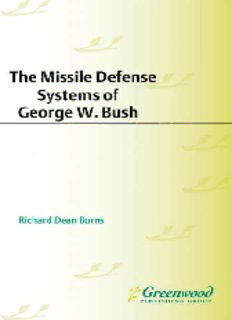
The Missile Defense Systems of George W. Bush: A Critical Assessment (Praeger Security International) PDF
Preview The Missile Defense Systems of George W. Bush: A Critical Assessment (Praeger Security International)
The Missile Defense Systems of George W. Bush This page intentionally left blank The Missile Defense Systems of George W. Bush A Critical Assessment RICHARD DEAN BURNS PRAEGER SECURITY INTERNATIONAL Copyright 2010 by Richard Dean Burns All rights reserved. No part of this publication may be reproduced, stored in a retrieval system, or transmitted, in any form or by any means, electronic, mechanical, photocopying, recording, or otherwise, except for the inclusion of brief quotations in a review, without prior permission in writing from the publisher. Library of Congress Cataloging-in-Publication Data Burns, Richard Dean. The missile defense systems of George W. Bush : a critical assessment / Richard Dean Burns. p. cm. Includes bibliographical references and index. ISBN 978-0-313-38466-0 (hard copy : alk. paper) — ISBN 978-0-313-38467-7 (ebook) 1. Ballistic missile defenses—United States. 2. Ballistic missile defenses—United States—History. 3. Bush, George W. (George Walker), 1946– 4. United States—Politics and government—2001–2009. 5. United States—Military policy. 6. World politics—1989– I. Title. UG743.B86 2010 358.1'740973090511—dc22 2010021795 ISBN: 978-0-313-38466-0 EISBN: 978-0-313-38467-7 14 13 12 11 10 1 2 3 4 5 This book is also available on the World Wide Web as an eBook. Visit www.abc-clio.com for details. Praeger An Imprint of ABC-CLIO, LLC ABC-CLIO, LLC 130 Cremona Drive, P.O. Box 1911 Santa Barbara, California 93116-1911 This book is printed on acid-free paper Manufactured in the United States of America Contents Preface vii Abbreviations ix Introduction 1 1 Missile Defense to ABM Diplomacy: From Eisenhower to Nixon 10 2 The Strategic Defense Initiative: From Reagan to G.H.W. Bush 32 3 Politics of Missile Defense Deployment: From William Clinton to George W. Bush 55 4 Missile Defense in Europe: Bush to Obama 79 5 North Korean and Iranian Missile Programs: Their Regional Impact 95 6 The Status of Missile Defense Systems 112 7 The Obama Administration and Missile Defense 133 Reflections 154 Notes 159 Selected References 177 Index 189 This page intentionally left blank Preface P resident George W. Bush’s controversial order to deploy a land-based ballistic missile defense in 2002, following the unilateral abrogation of the 1972 Antiballistic Missile [ABM] Treaty, did not end five decades of debate. Indeed, not only were old issues revisited but new ones arose, especially given the Bush administration’s efforts to extend America’s ballistic mis- sile defense (BMD) network to Central and Eastern Europe. Nor did the Bush administration’s efforts to use the new BMD system as a deterrent succeed in persuading the so-called rogue states of North Korea and Iran to halt their development of missiles or nuclear activities. This account, then, reviews the Bush BMD deployment after its first eight years and introduces the manner in which his successor, President Barak Obama, has sought to deal with the continuing issues. If this account’s objectives are met, readers should have sufficient data to judge whether these issues have been adequately assessed by American leaders and, with the deploy- ment of a missile defense system, whether the American public will actu- ally be protected by the system. F or the preparation of the introductory chapters, I have revisited an ear- lier work,The Quest for Missile Defense, 1944–2003 (2004), written in collab- oration with Professor Lester H. Brune. The first three chapters provide a brief background regarding the research and development of various bal- listic missile defense components as well as the pros and cons regarding the issue of actual deployment. A glossary is provided for easy reference to the acronyms used. A select bibliography is provided for those who wish to delve further into the issues. For those individuals uninitiated in the basic workings of ballistic missile and antiballistic missile systems, the chart following the Introduction may prove helpful. viii Preface Along the way, I have accumulated several debts. My wife, Glenda, encouraged me to stay with the challenge of preparing this study. My ear- lier coauthor, Lester H. Brune, provided a great deal of material for the initial study, some of which has found its way into this account. I espe- cially wish to acknowledge the efforts of senior editor Steve Catalano at ABC-CLIO Praeger in steering this study through to completion. Finally, I must acknowledge the vital assistance I have received from Philip Coyle; indeed, without his considerable efforts and material contri- butions it is unlikely that this book would have been completed. His read- ing of the manuscript and his willingness to share his extensive knowledge of the subject have helped me capture the technical features of the missile defense components. I owe Philip much for his encouragement, his kind- ness, and his perseverance. E ven so, I accept full responsibility for any errors that remain and all unattributed opinions offered in the text. Richard Dean Burns Claremont, California Abbreviations ABL Airborne Laser ABM Antiballistic Missile ACDA Arms Control and Disarmament Agency, U.S. AEC Atomic Energy Commission ALI Aegis Lightweight Exoatmospheric Projectile Intercept ALTB Airborne Laser Testbed ARPA Advanced Research Projects Agency ATBM Antitactical Ballistic Missile BMD Ballistic Missile Defense BMDO Ballistic Missile Defense Organization BMDS Ballistic Missile Defense System BP Brilliant Pebbles CFE Conventional Forces in Europe CIA Central Intelligence Agency DAB Defense Acquisition Board DIA Defense Intelligence Agency DSB Defense Science Board EKV Exoatmospheric Kill Vehicle (exoatmospheric = outside the atmosphere; endoatmospheric = inside the atmosphere) ERIS Exoatmospheric Reentry Interceptor Subsystem FAR Forward Acquisition Radar FOAB Father of All Bombs GAO General Accounting Office, U.S. GAPA Ground-to-Air Pilotless Aircraft GMD Ground-based Midcourse Defense (G. W. Bush)
Description: